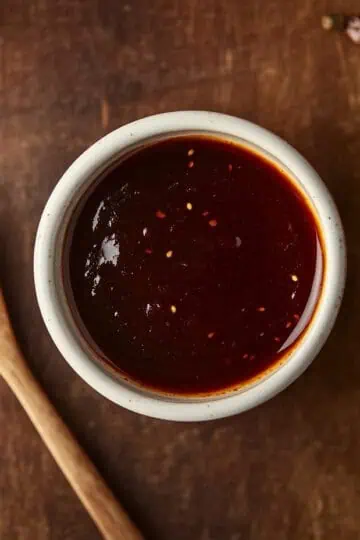Chinese Maki Soup has always been my rainy day comfort food. I first fell in love with it at the small restaurants in Binondo, where the soup would arrive steaming hot with tender pork slices floating in a crystal-clear broth.
After years of making this at home, I've simplified the traditional recipe while keeping its authentic taste. The secret? Tapioca starch for that signature glossy broth, and a simple meat-tenderizing trick that makes the pork so soft it melts in your mouth.
Whether you serve it plain or add noodles to make it Maki Mi, this soup is perfect for family lunches or when you're feeling under the weather. Don't be intimidated by its restaurant-style look, I promise it's easier to make than you think.
Cultural Notes
This soup is a beloved staple in Manila's Chinatown (Binondo), particularly along Ongpin Street. Its popularity spans generations and represents the beautiful fusion of Chinese and Filipino culinary traditions.
Jump to:

Why You'll Love This Recipe
- Authentic Heritage Recipe: Straight from the historic streets of Ongpin, Binondo
- Restaurant-Quality: The same recipe used by famous establishments like New Po Heng Lumpia House
- Versatile: Can be served as is or transformed into Maki Mi with noodles
- Budget-Friendly: Uses simple ingredients available in local markets
- Perfect for Any Weather: Comforting during rainy days and satisfying year-round
Ingredients
The ingredients in this Maki Soup were carefully selected to create an authentic Binondo experience. Pork tenderloin provides the perfect texture when tenderized with baking soda - a traditional Chinese technique that breaks down proteins for melt-in-your-mouth results.
Dried shiitake mushrooms add essential umami depth that fresh varieties can't match. Tapioca starch, unlike regular cornstarch, creates the signature glossy, translucent broth that defines true Maki Soup. The delicate egg strands and aromatic sesame oil finish the dish with subtle richness, while spring onions add brightness and color.
Together, these ingredients balance simplicity with technique, allowing you to recreate generations of Filipino-Chinese culinary wisdom in your own kitchen.

For the Meat Marinade:
- 500g pork tenderloin, thinly sliced
- 2 tablespoons Chinese cooking wine (Shaoxing wine)
- 1 tablespoon light soy sauce
- ½ teaspoon baking soda
- 2 cloves garlic, minced
- Salt to taste
- Freshly ground black pepper to taste
For the Soup:
- 4 pieces dried shiitake mushrooms
- 4 cups beef stock
- 1 cup hot water
- ½ cup tapioca starch
- Soy sauce to taste
- 3 tablespoons cornstarch
- 1-2 eggs
- Spring onions, chopped
- Sesame oil
Equipment
- Large pot: For cooking the soup base and combining all ingredients
- Kitchen hammer/mallet: Essential for tenderizing the meat properly
- Mixing bowls: For marinating meat and preparing the starch mixture
- Measuring cups and spoons: For precise ingredient measurements
- Fine-mesh strainer: Ensures a smooth, lump-free soup texture
- Wooden spoon: For gentle stirring that won't break the delicate egg strands
- Sharp knife: For thinly slicing the meat (crucial for proper texture)
- Cutting board: Provides stable surface for meat preparation

How To Make
- Begin by soaking 4 dried shiitake mushrooms in hot water for 30 minutes until they're soft and plump. Reserve the soaking liquid for added depth of flavor.
- Take your 500g pork tenderloin and slice it very thinly. Cover the slices with plastic wrap and gently pound them with a kitchen mallet until they're about ¼ inch thick. This crucial step tenderizes the meat and allows for quick cooking.
- In a large bowl, combine 2 tablespoons Chinese cooking wine, 1 tablespoon light soy sauce, ½ teaspoon baking soda, 2 minced garlic cloves, and a pinch each of salt and pepper. Add your pork slices to this marinade and refrigerate for 30 minutes.
- After marinating, coat each piece of pork with cornstarch. Shake off any excess and set aside.
- Pour 4 cups of beef stock into a large pot. Add the soaked mushrooms, their soaking liquid, and a splash of soy sauce. Bring this to a boil over medium heat, then reduce to a simmer for 2 minutes.
- Drop the cornstarch-coated pork pieces into the simmering broth one at a time to prevent them from sticking together.
- In a small bowl, mix ½ cup tapioca starch with ½ cup cold water until smooth. While stirring the soup constantly, slowly pour in this mixture a little at a time until the soup reaches your desired thickness. Keep the heat low to maintain a gentle simmer.
- Beat 1-2 eggs in a bowl. While stirring the soup in one direction, slowly pour in the beaten eggs to create delicate strands.
- Season your soup with a few drops of sesame oil and salt to taste. Ladle into bowls and top with chopped spring onions.
- Serve hot, either on its own or with steamed rice. To make Maki Mi, simply add cooked fresh egg noodles to your bowl before pouring in the hot soup.

Tips from Lola's Kitchen
For Perfectly Tender Meat:
- Always slice the pork against the grain for maximum tenderness
- The baking soda in the marinade is non-negotiable—it breaks down proteins for that signature melt-in-your-mouth texture
- Pound the meat evenly to ensure consistent cooking and texture
- Make sure your knife is extremely sharp for the thinnest possible slices
For Glossy, Perfect Soup:
- Add the tapioca starch mixture gradually while constantly stirring to prevent lumps
- Keep your soup at a gentle simmer, never a rolling boil, especially after adding the starch
- If you want a clearer broth, strain your beef stock before using
- The direction of stirring matters when adding the egg—maintain a consistent circular motion
Substitutions
- Meat Options: Substitute chicken breast for pork to make Chicken Maki (slice and tenderize using the same technique)
- Mushroom Alternatives: Button mushrooms can replace shiitake, though they provide less umami flavor
- Stock Base: Chicken stock works well if beef stock isn't available
- Starch Options: Cornstarch can substitute for tapioca starch but will create a slightly different texture and clarity
- Wine Substitutes: Dry sherry or a tablespoon of rice vinegar can replace Chinese cooking wine
Troubleshooting
Soup Too Thick:
- Add hot beef stock gradually while stirring constantly until desired consistency is reached
- Never add cold liquid to thin the soup as it may cause lumping
Soup Too Thin:
- Mix 1 tablespoon tapioca starch with 2 tablespoons cold water
- Add to simmering soup gradually while stirring continuously
- Remember that the soup will thicken slightly as it cools
Meat Is Tough:
- Ensure proper marination time (minimum 30 minutes)
- Check that you've sliced against the grain
- Verify that you've pounded the meat sufficiently thin
- Make sure your broth isn't boiling when you add the meat
Egg Forms Clumps Instead of Strands:
- Ensure soup is at a gentle simmer, not boiling
- Pour egg mixture in a very thin stream while stirring consistently
- Use a fork to beat eggs thoroughly before adding
Storage & Reheating
Storage:
- Refrigerate in an airtight container for up to 3 days
- Store the broth and meat separately from any noodles if making Maki Mi
Freezing:
- Not recommended due to the starch content, which can separate when thawed
- The meat can be frozen separately before cooking if needed
Reheating:
- Stovetop (preferred method): Reheat over low heat, stirring occasionally to prevent sticking
- Microwave: Heat for 2-3 minutes at medium power, stirring halfway through
- Add a splash of water or stock if the soup has thickened too much during storage
- Never bring to a boil when reheating as this can toughen the meat

FAQ
Why is my soup not as translucent as restaurant versions?
The signature translucency comes from properly dissolved tapioca starch. Make sure to mix it thoroughly with cold water before adding, and incorporate it gradually while continuously stirring.
Can I make this recipe in advance for a party?
While best served fresh, you can prepare the components separately, marinate and tenderize the meat, prepare the broth base, and mix the starch solution. Combine everything and add the eggs just before serving.
How thin should I slice the pork?
Aim for ⅛ inch (3mm) thickness. The meat should be almost translucent when held up to light. A partially frozen tenderloin is easier to slice thinly.
Is this soup gluten-free?
Not in its traditional form. To make it gluten-free, use tamari instead of soy sauce and ensure your stocks and seasonings are certified gluten-free.
What's the difference between Maki Soup and other Chinese soups?
The distinctive features are the specially tenderized meat and the tapioca starch that creates the signature glossy, translucent broth, techniques perfected in Manila's Chinatown.
How can I make this soup more filling?
Transform it into Maki Mi by adding fresh egg noodles, or serve with steamed rice on the side. You can also increase the protein by adding more meat or including quail eggs.
Related
Looking for other recipes like this? Try these:

Authentic Chinese Maki Soup Recipe
Equipment
- Large pot (kaldero) For cooking the soup
- Kitchen Hammer/Mallet (Pamukpok) For tenderizing the meat
- Mixing bowls (mangkok) For marinating and mixing ingredients
- Measuring cups and spoons (Panukat) For precise measurements
- Fine-mesh strainer (salaan) For ensuring smooth soup texture
- Wooden spoon (sandok na kahoy) For gentle stirring
- Sharp knife (kutsilyo) For slicing meat and vegetables
- Cutting board (Sangkalan) For preparation work
Ingredients
For the Meat Marinade:
- 500 g pork tenderloin thinly sliced
- 2 tablespoon Chinese cooking wine Shaoxing wine
- 1 tablespoon light soy sauce toyo
- ½ teaspoon baking soda pampalambot
- 2 cloves garlic bawang, minced
- Salt asin to taste
- Freshly ground black pepper paminta to taste
For the Soup:
- 4 pieces dried shiitake mushrooms kabute
- 4 cups beef stock sabaw ng baka
- 1 cup hot water mainit na tubig
- ½ cup tapioca starch galapong
- Soy sauce toyo to taste
- 3 tablespoon cornstarch cornstarch
- 1-2 eggs itlog
- Spring onions dahon ng sibuyas, chopped
- Sesame oil
Instructions
- Begin by soaking 4 dried shiitake mushrooms in hot water for 30 minutes until they're soft and plump. Keep the soaking liquid - you'll use it later for extra flavor.
- Take your 500g pork tenderloin and slice it very thinly. Cover the slices with plastic wrap and gently pound them with a kitchen mallet until they're about ¼ inch thick. This makes the meat tender and helps it cook quickly.
- In a large bowl, mix together 2 tablespoons Chinese cooking wine, 1 tablespoon light soy sauce, ½ teaspoon baking soda, 2 minced garlic cloves, and a pinch each of salt and pepper. Add your pork slices to this marinade and let them rest for 30 minutes in the refrigerator.
- After marinating, take each piece of pork and coat it with cornstarch. Shake off any excess and set aside.
- Pour 4 cups of beef stock into a large pot. Add the soaked mushrooms, their soaking liquid, and a splash of soy sauce. Bring this to a boil over medium heat (175°C/350°F), then reduce to a simmer for 2 minutes.
- Now drop the cornstarch-coated pork pieces into the simmering broth one at a time to prevent them from sticking together.
- In a small bowl, mix ½ cup tapioca starch with ½ cup cold water until smooth. While stirring the soup constantly, slowly pour in this mixture a little at a time until the soup reaches your desired thickness. Keep the heat low to maintain a gentle simmer (82°C/180°F).
- Beat 1-2 eggs in a bowl. While stirring the soup in one direction, slowly pour in the beaten eggs to create delicate strands.
- Finally, season your soup with a few drops of sesame oil and salt to taste. Ladle into bowls and top with chopped spring onions.
- Serve hot, either on its own or with steamed rice. If you'd like to make Maki Mi, simply add cooked fresh egg noodles to your bowl before pouring in the hot soup.
- For best results, serve immediately while the soup is hot and the meat is at its most tender. Remember to stir your soup gently before serving to mix all the ingredients evenly.
Tips from Lola's Kitchen
- For tender meat:
- Slice against the grain
- Don't skip the baking soda in marinade
- Pound meat evenly
- For perfect soup texture:
- Add tapioca starch gradually
- Keep stirring to prevent lumps
- Maintain temperature below boiling after adding starch
Nutrition
The Story Behind Chinese Maki Soup
Every bowl of Chinese Maki Soup tells a story of Manila's historic Chinatown, where the busy streets of Binondo have been serving this comforting dish for generations. While many know Binondo for its famous dumplings and lumpia, it's the lesser-known Maki Soup that truly captures the essence of Filipino-Chinese comfort food.
Walking down the bustling Ongpin Street, you'll find this soup simmering in family-run restaurants that have been around for over 50 years. Places like New Po Heng Lumpia House and Ongpin Mañosa Restaurant have made this dish a local favorite, especially during the rainy season when Manileños seek warm, satisfying meals.
What makes this soup special is its unique preparation method. The name "Maki" comes from the special technique of tenderizing the meat until it becomes incredibly soft – a cooking secret that Chinese immigrants brought to Philippine shores. This technique, combined with the use of tapioca starch for that signature glossy broth, creates a texture that sets it apart from other Chinese soups.
Today, Maki Soup has evolved to include different variations. The most popular is Maki Mi, where egg noodles are added to make it a more filling meal. Some families pass down their own versions, adding quail eggs or different mushroom varieties, but the heart of the dish remains the same: tender meat swimming in that distinctively clear, silky broth.
Whether you're caught in Manila's afternoon rain or simply craving a taste of Binondo at home, this soup brings together the best of Filipino and Chinese flavors. It's more than just a recipe – it's a bowlful of Manila's culinary heritage, perfected through decades of family traditions and street-side expertise.










Comments
No Comments